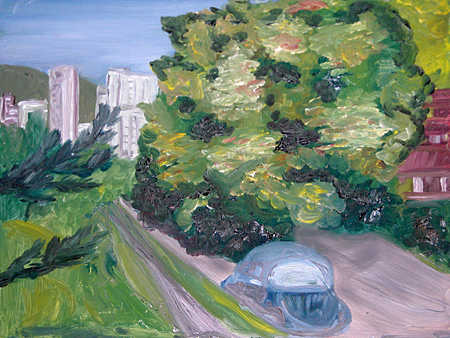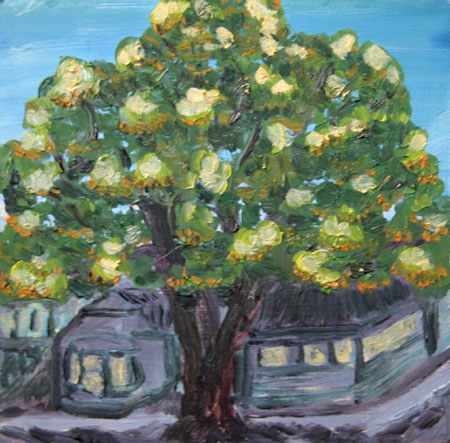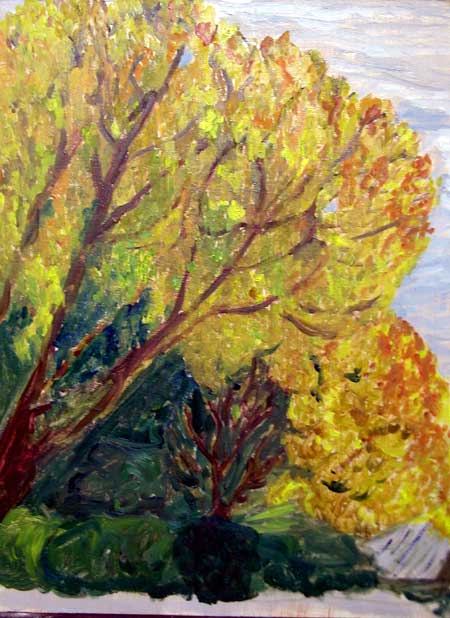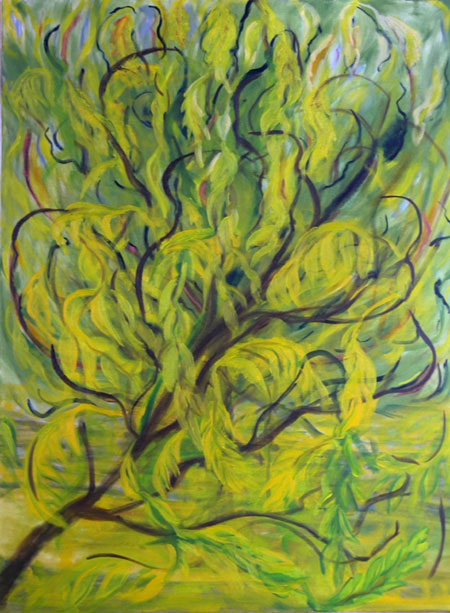I’m maundering around Robert Irwin and the concept of perception. It was the Oct 14 NY Times article on Irwin that got me thinking — again — about what and how and why we perceive.
Irwin, in one of his exhibits, made a small but significant change to a San Diego Museum room that overlooked a wide view of the Pacific ocean. His exhibit consisted of cutting three rectangles into the existing windows. The Times quotes Irwin, “At first I didn’t realize the glass was tinted….So not only did my holes let in air and sound, adding another dimension to the experience, but they made everything seen through them appear in greater focus.” The reporter adds that Irwin “opened the window, that age-old pictorial device, letting in a cool rush of reality.”
Alternatively, I think I spend much of my time in reality. So, to reverse Irwin, I’ve been painting “stuff” around my neighborhood base. No sweeping views of vales and rivers, of volcanoes and archaic structures. Instead, I’m trying to perceive, in a painterly fashion, the place I spend most of my time. As usual for me, it consists of much that is “natural,” that is, growing things.
As usual, it’s outside, where I can enjoy the sun (when it shines) and the air and light.
 Volkswagen and Horse Chestnut tree, 12 x 16, Pleine aire
Volkswagen and Horse Chestnut tree, 12 x 16, Pleine aire
In some ways, it feels to me like I’m going through Irwin to the other side — his concern is art “as a vehicle for attuning or returning individual patterns of attention and perception.” Mine is to stop seeing the world as full of my visual life and to see it as a painting.
I’m paying attention to my world, not just familiar, comforting, as city, full of interesting characters, Pacific northwest, foliage eating houses, but as containing appropriate scenes for painting. And painting as I can perceive it as well as the way it normally confronts me.
This is, of course, the traditional task of painters. And yet, thinking this way — what to paint, why to paint, how to paint — about my quotidian world, cuts open that window and makes me perceive more attentively and quite differently. The contemplation of painting the scenes opens them up.
irwin says “In a way it’s a simple thing. For the next week, try the best you can to pay attention to sounds. You will start hearing all these sounds coming in. Once you let them in, you’ve already done the first and most critical thing, you’ve honored that information by including it. And by doing that you’ve actually changed the world. It’s nothing mystical but you’ve redefined the world for yourself.”
So today, in keeping with the idea of furthering my education as an attentive eye, I put on a sound-deadening headset (meant for chain saw operators, I think), to see if cutting out one of the senses might sharpen another. You remember I said it was easier to listen to sounds if I closed my eyes. So I closed my ears to check out the view. But, it didn’t work that way. Neither looking at the view nor painting it was changed by my headset. I think it’s because viewing is so primary to the human consciousness that it takes precedence. So we already have a kind of sound-deadening mechanism when we pay full attention to seeing. And in painting a further attribute of the activity is physical — if I’m not paying attention to seeing, I’m paying attention to moving the brush as I want it to move.

Strange tree with houses 7 x 10, pleine aire
Irwin’s charge to himself is to alter the site in order to break the viewer’s preconceptions and bring new perceptions. My charge to myself was to stop looking, smelling, enjoying, strolling, conversing, checking out the neighborhood, and look at it solely as providing painting opportunities. It was a whole new view of where I live.

Ash Tree at Sunset, 12 x 16, pleine aire
So, the question I pose to you is, how do you break through your preconceptions and normal perceptions. If you are accustomed to seeing everything as potential for some art — what might break that perception. And vice-versa, when what you see is too quotidian, too daily, to be art, what can you do to see it otherwise. Or is it wise to even try?
 Ash Tree, Looking Up (in Process) 36 x 48, studio
Ash Tree, Looking Up (in Process) 36 x 48, studio

June,
I especially like “Volkswagen and Horse Chestnut Tree”. It is unassuming, amusing and direct.
The others are nice, too, but more formal.
June,
I feel your energy in your paintings too.
In the first painting, there is streaming from the solidity of the buildings in the left background to the trees pushing the Volkswagen space capsule symbol downwards. I don’t get the red (wonderful red) building in the right foreground.
In the second one, a proud tree is parading in front of the houses. I generally think of trees as male (der Baum in German) but this tree is clearly female. You do love symmetry.
I cannot relate to the third painting because of my emotional hang-up for pictures of autumn foliage.
The unfinished last picture is my favorite. I am dancing inside the tree.
D.
The volkswagen piece was, appropriately, done in an amusing moment. I hadn’t painted a vehicle for years (maybe never — the last ones were drawn) and I was chatting with (nosy) neighbors while sitting at the corner painting the tree and the house. Just as I realized that I could go no further until I tackled the VW, my neighbor John, a car fanatic, appeared with his toddler. “Where’s the car?” he asked, being a bit of tease. So I swirled it into place and the both of them laughed out loud. It was a good moment and so defined the painting, too.
Birgit, don’t ask me what that red is doing. It was there, I was avoiding the car, and so it happened.
Sorry about the autumn leaves. The ash trees surround our house on two sides and are really pushy about their leaf change. They are the first to go, and the first to glow gold, and the first to clutter the sidewalk. Maybe I should paint the sidewalk. (I sometimes think of these trees as city bureaucrats — they march down the street, all puffed up and serious, but really, just tawdry little street trees.
I’ll try to keep the dance in the last piece.
But, the question, the question — Birgit, while writing this, I was thinking of you looking at dunes, first as a lover of them, but increasingly, it seems from your photos, as a photographer. I think that your early photos were like Steve’s Elusive Lake — meaningful, but without meaning unless you knew the meaning. But your later ones resonate with a vision made external. How did you come to that place?
D. — have you ever had to stop perceiving in one way just to upset the apple cart? To move beyond seeing as an artist, or as a lover, or as a neighbor strolling through her world?
Thank you, June, it was love.
I am celebrating just having painted a blue oil undercoating on a fresh piece of linen for two of my beachscapes. My first baby steps.
Karl, do you hear?
Way to go, Birgit. It doesn’t hurt at all, honest. I’m smiling.
June,
“…to move beyond…”
I don’t quite see it this way. Instead, I am just me and outside of me is all of this and this and that and Everything and I am just trying to observe what happens around me and maybe move closer, trying to make some kind of sense of it while I can.
Do you like Edouard Vuillard?
I am curating a show here on campus where everyone who attends must select a favorite artwork. A print on standard copy paper will be made and placed side-by-side with the others. I really like how all of us will be together in the same room, intermingling next to the (quilted?) work.
I have selected EV’s “Interior, Mother and Sister of the Artist.”
I do like Vuillard very much. He intrigues me. And your selection is wonderful. If it’s the one I’m thinking of, it’s quite off-center — one of the women is bent over right at the top of the picture frame, and the two women are center and left with not much to weight the right. It’s wondrous weird.
I don’t know anything about him, except that he does figures like I’d like to do figures — a kind of devil-may-careness about them.
And what a good idea for a participatory exhibit. I wonder if the results would show what those Russians (whose names I can never remember) found out about people’s tastes in paintings. Of course, you have a much more selective attendance.
When I asked the staff at the Fossil Beds Monument to tell me places to paint, the hardest request I got came from two people — it was perhaps the Park’s most predictably famous feature, but it’s charm eluded me. It was, however, where we stepped around cow pies and watched for the cougar who had apparently spooked the horses the night before.
Don’t ask why I’m thinking about that — people’s tastes, I guess.
June,
I am also extending the gallery show to an online one too. I would be very interested to know what you (and others) would select as your favorite artwork.
D.
When faced with the actual task, “select your favorite artwork” I suddenly freeze.
I have the same trouble at Ben and Jerry’s, although there at least it’s a temporary choice, able to be redacted tomorrow.
Can we narrow it a bit? Favorite museum piece? Favorite for over my dining table? Favorite contemporary? Favorite when I’m ill? Favorite when my outlook is doom and gloom — or the reverse? Favorite among my own work?
Well, you see my difficulties. And now that I’ve mentioned all this, I’m sure that I’ve prejudiced everyone else on the list and we’ll all have to weep about the impossibility of the task.
Worse, off the top of my head, I can’t think of a single piece of art. Including one by J. Underwood.
June,
It is a given that this may be temporary, though in my case, the Vuillard has for a long time lingered.
Favorite temporary, then. Cezanne, Quarry and Mont Sainte-Victoire (precdictable, eh?)
And secondary/temporary, unpredictable (but as Birgit says, I like symmetry), Van Gogh’s drawing, “Cemetary in the Rain.”
Thanks June. What about your husband, does he have a favorite?
June,
I like your Tree best – bet you’re not surprised. It seems partway towards the abstraction of Sunil’s recent post. I agree with D. that it is less direct, but that’s what I like; it’s more transformed by you.
In answering your question: I don’t always walk around considering everything as fodder for art, but I do often enough that I’m not worried about having a hard time finding a subject. It’s much more often a case of too many subjects for time available. At the same time, it’s not rare to go somewhere with photography in mind and decide not to make any photographs after all. Sometimes that may well be due to preconceptions getting in the way.
I don’t have any special method for trying to see fresh. But I usually work on projects where I keep going back to the same place, and I often find that I see different things going back in a different mood or with different ideas in mind. I just experienced this yesterday. I was at a small waterfall (an old subject, though a new location) that didn’t seem too exciting. I was considering a particular subject and was about to leave when I recalled something from a conversation with an artist earlier in the day. I ended up making some photographs that, perhaps, may not seem so different from others I’ve made, but I was thinking about them differently.
June,
The Ash Tree (looking up) is very fascinating. It must have been fairly difficult for you to capture that kind of unity in the lines over four feet of vertical canvas. Kudos on your painting skills. Nice one.
I was very intrigued by Robert Irwin, but what struck me the most in this discussion was the quote by David Estes (D.) when he said the following:
“I am just me and outside of me is all of this and this and that and Everything and I am just trying to observe what happens around me and maybe move closer, trying to make some kind of sense of it while I can.”
Although I could never have said it so eloquently, I try and approach the same ideal of late… Try to make sense of disparate things and in the process understand the world better and spawn multiple parallel self created projects that I attend to when I have the time.
Very stimulating discussion. Like Steve, I also go back to projects, not completed works (like he does sometimes), but additional bodies of work that can then be added to existing projects making it richer as well as more unified.
Once when I was painting out in the woods and felt like I needed a break in my thinking, I (in a goofy homage to Native Americans) put my ear on the ground and did a bunch of drawings, with my ear on the ground, of what I saw sideways. They were not especially good drawings, nor a true homage to Native Americans–only a product of Tonto and TV stereotypes probably–but it loosened up the thinking.
I later saw a Vito Acconci piece in Chicago where he took photos with the camera on his hip, on his shoulder, etc. Again, not good photos, but I appreciated the iconoclasm. I guess it also illustrates how ideas are “in the air”, and when you think you’re original, oops, not.
Martha,
I’m not especially known for free play (I’m no Jay), but somehow that idea really strikes me as intriguing. I’m going to try it with my camera sometime soon. Hopefully I won’t get stomped by a horse…
Too tired right now to contemplate perceptions but I fell off the wagon a while ago and am trying to catch up with the posts.
Love your paintings, June.
I like the last painting best, its free, organic, and soothing. It also has a stronger energy.
June:
Don’t do too much to Tree Looking-up. You must be hearing the ghost of Willem deKooning in those earmuffs of yours. Actually the ghost of the elder deKooning, assuming that one can channel age-specific ghosts.
We once had a Volkswagen like the one in your first picture – but more deeply blue. The painting overall presents a close but alternative universe – one that I like.
June,
Showing Troels your images, this is what he said:
“Strange tree with houses: “go more slowly, this picture reminds me of something”.
Ash Tree at Sunset: “This picture, I even like more”
Tree, Looking Up” this picture is interesting.”
I am enjoying your trees, June. The movement in the first painting is appealing. The car has been rushing to the city in the background, and is stopped by the tree or something. I like how the tree is engulfing the house in the 2nd painting, but the composition seems quite stiff. The bend of the fall trees in the 3rd is more appealing. The last painting is wonderful; it seems close to done to me. The freedom of the your brush strokes seems to have captured the tree’s energy (both the wind outside it and the life pulsing through it). I prefer your less formal work. Don’t over think it.